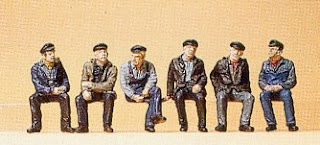Here come the paying passengers! Filling #107 with folks.
Funny that Preiser folks are pricey. Pricey Preiser. But truth is, Preiser offers some outstanding figures. Best on the market if you ask me. So I really like using them in my modeling. But averaging over $3 per folk and rising, and each Niles car requiring around 25 figures each, well I'm going to place them strategically.
The Preiser site has cool photos of models modeling for the figure modeler modeling figures. (as an interresting side note, Germans make a distinction between human "models" and miniature "modelles"). Check it out.
Not only are Preiser figures well done, they are also available in era specific costume. So I picked up their 1900 era figures for the 1908 vintage Niles trolleys. Here is #12136 Seated Persons (above, with parasols removed),
#12137 Seated Persons, (I don't know what I'm going to do with that cat.).
#12190 Seated Passengers, (my favorite. I think these are very nicely done).
#10351 Seated Industrial Workers. (The working class ride the trolley too).
#12191 Railway Personnel.(remove the shovels and we got our trolley crew).
Woodland Scenics (#A1908 Sixteen Passengers) on the other hand, aren't quite as sophisticated as Preisers, but they are full of character and somewhat "generic" enough that they can fit many eras. Considering that the closest we ever get to HO models is about a scale block away, Woodland Scenic folks will work just fine. Especially at a third of the cost of Preisers, Woodland Scenics figures average about $1.25 per folk.
So here is the plan. The Niles cars are "California Cars" which means they have a glassed in center section and open air sections on the ends. So...
The pricey Preicer figures will adorn the open end sections where they are more easily seen and appreciated, and the Woodland Scenic characters will ride in the enclosed center section behind the glass windows. The figures are glued in with good ol' Micro Kristal Kleer because of its rubbery characteristics. If a figure is accidentally bumped, its less likely to snap off.
Some of the seats couldn't be filled because of mountings for the motor and shell. But I did manage to fit 24 figures in there! 25 if you count the double figure of a man with a child on his lap.
This is where the bulkhead of the shell attaches to the floor. So only the seat backs are present.
Have a Happy Thanksgiving Folks!
Dandy
















